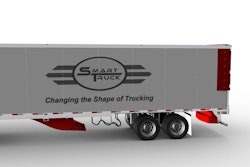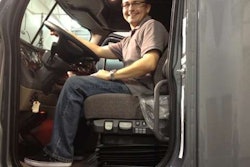 FlowBelow’s Tractor AeroKit system of aerodynamic devices includes wheel covers and is designed to work with many different wheel and tire configurations, including super singles.
FlowBelow’s Tractor AeroKit system of aerodynamic devices includes wheel covers and is designed to work with many different wheel and tire configurations, including super singles.Any vehicle moving at highway speeds faces the impediments of drag, which is created in two ways.
One is when anything – rearview mirrors and bug screens, for example – impedes the smooth flow of air around the vehicle. Drag also is created by a vacuum – a low-pressure area that sucks in air that ideally would flow smoothly past the vehicle. The result is turbulence.
While bumper-mounted air dams, wheel coverings and trailer side skirts and tails have improved airflow underneath and around tractor-trailers dramatically, the trailer gap remains a stubborn aerodynamic challenge for engineers.
 VorBlade’s small vortex generator blades are wishbone-shaped airfoils that smooth airflow over a truck’s trailing edges like the back of a cab or trailer.
VorBlade’s small vortex generator blades are wishbone-shaped airfoils that smooth airflow over a truck’s trailing edges like the back of a cab or trailer.“The trailer needs to articulate,” says Mario Bravo, director of marketing for FlowBelow, which makes the AeroKit package of tractor-trailer aerodynamic devices. “Because there are many trailer and tractor configurations, having to design and build many variations of any solution makes it difficult for a manufacturer to reach economies of scale and offer their product at an attractive price.”
While the gap area is not the largest component of tractor-trailer drag, it is made more challenging by other issues, says Mike Henderson, chief scientist for SmartTruck, which makes the UT6-Plus aerodynamic package for trailers. Computation fluid dynamics and testing have shown that gap drag results from low pressure in the gap reacting on the rear of the tractor and its fairing and the front of the trailer, Henderson says.
The solution, he says, is to close the gap or place fairings on the front of the trailer’s top and sides. The larger the gap, the larger the fairings needed.
Andrew Smith, chief executive officer of ATDynamics, favors a tractor-related solution. “Because of the variation between trucks and trailers, the winning technology to address this area of drag will be as universal as possible and will be tractor-mounted, given the high ratio of trailers to trucks in most fleets,” Smith says.
Small vortex generator blades – wishbone-shaped airfoils that smooth airflow over a truck’s trailing edges like the back of a cab or trailer – also can help, says VorBlade’s Natalie Melomed. “It might be counterintuitive, but small-scale vortex generators destroy harmful turbulence by intensifying the mix between different pressure zones and compensating the pressure jump,” Melomed says. “VorBlades actually reduce drag in the gap and increase vehicle stability.”








